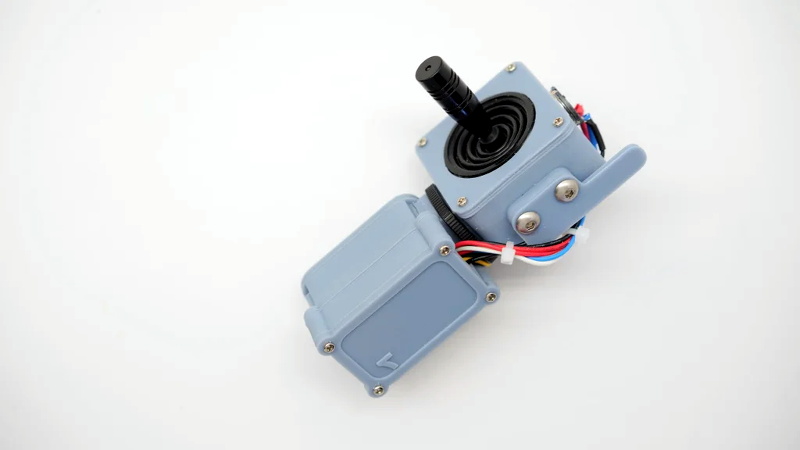Wanting a simple tool to aid in the development of LoRa controlled robotic projects, [Jay Doscher] put together this very slick one-handed controller based on the 900 MHz Adafruit Feather M0. With a single trigger and a miniature analog joystick it’s a fairly simple input device, but should be just enough to test basic functionality of whatever moving gadget you might find yourself working on.
 Wiring for this project is about as simple as you’d expect, with the trigger and joystick hanging off the Feather’s digital ports. The CircuitPython code is also very straightforward, though [Jay] says in the future he might expand on this a bit to support LoRaWAN. The controller was designed as a barebones diagnostic tool, but the hardware and software in its current form offers an excellent opportunity to layer additional functionality on a known good base.
Wiring for this project is about as simple as you’d expect, with the trigger and joystick hanging off the Feather’s digital ports. The CircuitPython code is also very straightforward, though [Jay] says in the future he might expand on this a bit to support LoRaWAN. The controller was designed as a barebones diagnostic tool, but the hardware and software in its current form offers an excellent opportunity to layer additional functionality on a known good base.
Everything is held inside a very well designed 3D printed enclosure which [Jay] ran off on his ELEGOO Mars, one of the new breed of low-cost resin 3D printers. The machine might be pretty cheap, but the results speak for themselves. While resin printing certainly has its downsides, it’s hard not to be impressed by the finish quality of this enclosure.
While LoRa is generally used for transmitting small bits of information over long distances, such as from remote sensors, this isn’t the first time we’ve seen it used for direct control of a moving object. If you’re not up to speed on LoRa, check out this excellent talk from [Reinier van der Lee] that goes over the basics of the technology and how he used it to build a community sensor network.
















The difficulty with LoRa is still the limited transmission limits on the ISM bands. Typically you’re not allowed to transmit more than 1% of the time, so continuous signaling is not possible. Otherwise you may get in trouble with the authorities.
Not allowed? Meh. As long as no one sees you you can transmit whatever you want.
‘Zackly.
I’m hoping that’s just sarcasm. The reality though is that it depends on where you are in the world. Areas with low population, low education, and commercial industry will probably not have any knowledgeable radio hobbyists to turn you in, but there is always that slim occurrence that someone sees it and decides to rat you out because they can. Around here you could blast several kw of dirty radio and it world take years before anyone stopped to ask why their TV was buzzing all the time.
The rules are there for a reason.
In the EU the 433 band has power and duty cycle limitations, so depending on your transmitter you can do 1%, 10% or 100%, but in the 868 band you’re pretty much limited to 1% because there’s all sorts of commercial sensors using that frequency – bigger businesses start to care when they can’t read their smart meters due to you jamming the channels.
To the best of my knowledge the duty cycle restriction is per channel so depending on the number of channels available in your region and country you may be able to interleave channels to get a slightly higher limit ( http://i.imgur.com/6puyLtt.jpg ).
You can find out a lot about the different regions at https://lora-alliance.org/lorawan-for-developers click on “LoRaWAN Regional Parameters” and check the number of channels in the region that interests you. It appears to be a living document that is constantly being updated.
In germany there are parts of the ISM-spectrum that aren’t under such restrictions. (in both parts 433MHz and 860MHz)
Source: https://www.bundesnetzagentur.de/SharedDocs/Downloads/DE/Sachgebiete/Telekommunikation/Unternehmen_Institutionen/Frequenzen/Allgemeinzuteilungen/2018_05_SRD_pdf.pdf?__blob=publicationFile&v=2
For the 860MHz part (869,3 – 869,4 ) there seems to be another kind of limitation. You have to use a access protocol like it is dicribed in the norm ETSI EN 301 391 part 6 (source: https://www.etsi.org/deliver/etsi_en/301300_301399/301391/01.01.01_30/en_301391v010101v.pdf). I don’t konow if this is allreaddy implemented in the LoRaWAN Standart.
Thanks! The current code on Github is *very* basic but when done should not break the rules- the goal is only to do occasional tests for connectivity and remote control.
eventually i plan on sticking a lora radio in my pi tablet. which has hardpoints for external controllers.
So, it looks to me a lot like the joystick on NASA’s EVA backpack.